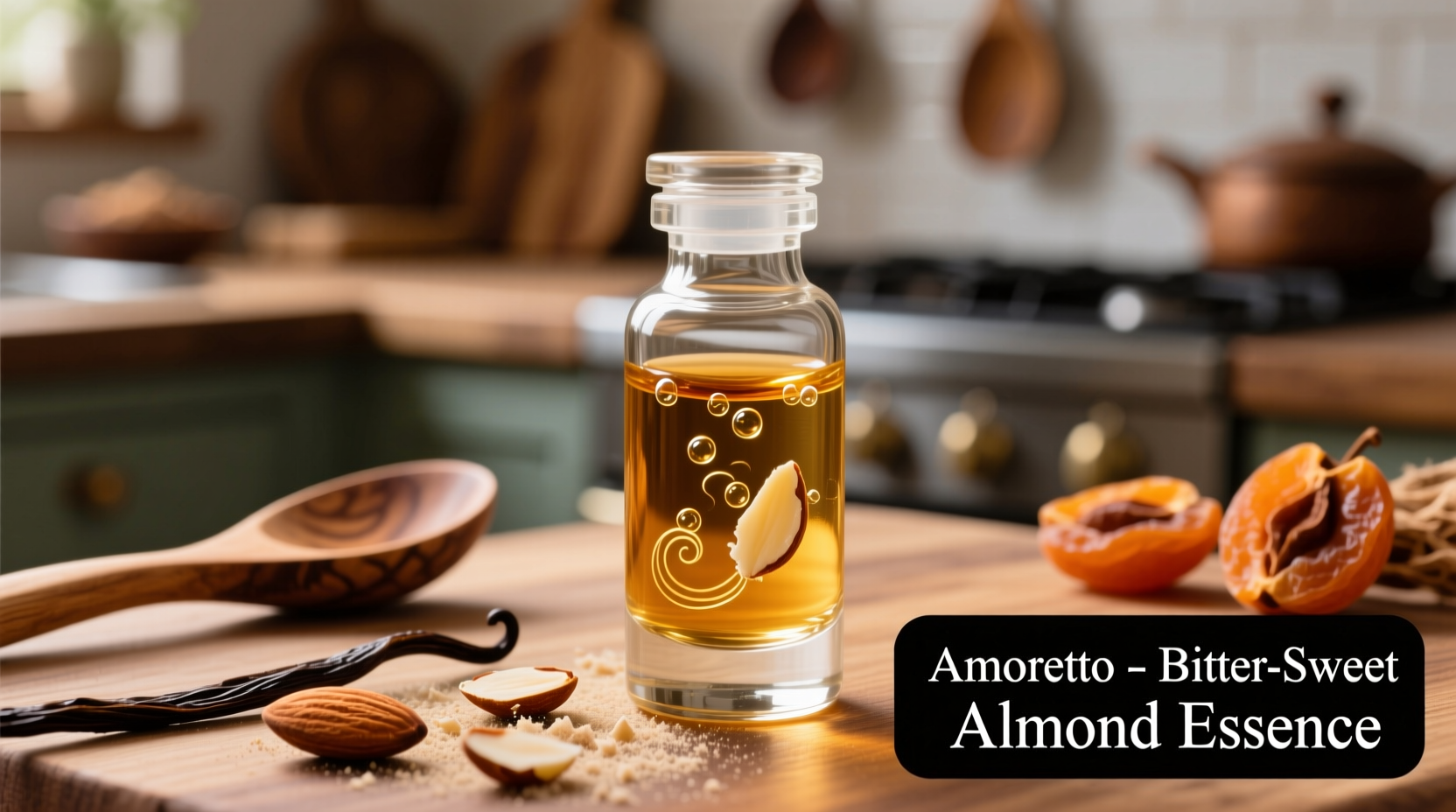Curious about that distinctive sweet-nutty essence in your favorite Italian cookies or cocktails? Understanding amaretto flavor goes beyond just labeling it “almond-flavored.” This comprehensive guide reveals the true origins, chemical composition, and culinary applications of this beloved flavor profile that has enchanted palates for centuries.
The Core Identity of Amaretto Flavor
Despite its name suggesting almond (amaretto means “little bitter” in Italian), authentic amaretto flavor primarily comes from the pits of stone fruits like apricots, peaches, and cherries. These pits contain amygdalin, a compound that breaks down into benzaldehyde during processing—the key chemical responsible for that characteristic marzipan-like aroma and taste.
According to research from the US Department of Agriculture, benzaldehyde constitutes 90-95% of the volatile compounds in amaretto flavoring, creating its signature profile that’s simultaneously sweet, nutty, and slightly bitter. This chemical composition explains why amaretto flavor differs significantly from pure almond extract, which comes from actual bitter almonds.
Historical Evolution of Amaretto Flavor
Tracing back to 16th century Italy, amaretto flavor emerged from resourceful culinary traditions where nothing went to waste. Historical records from Saronno, Italy, document the earliest known amaretto liqueur created around 1525 using apricot kernels, sugar, and neutral spirits. This innovation transformed potentially toxic stone fruit pits into a safe, delightful flavoring through careful distillation.
| Time Period | Development | Significance |
|---|---|---|
| 1525 | First documented amaretto liqueur in Saronno | Used apricot pits instead of almonds due to regional availability |
| 1851 | Commercial production begins | Lazzaroni family establishes first amaretto distillery |
| Early 1900s | Flavoring extracts developed | Made amaretto flavor accessible for home baking |
| Modern Era | Synthetic benzaldehyde production | Created consistent, affordable amaretto flavoring worldwide |
Amaretto Flavor vs. Almond Extract: Key Differences
Many home bakers confuse amaretto flavor with almond extract, but they’re distinct:
- Source Material: Amaretto flavor comes from stone fruit pits; almond extract comes from actual bitter almonds
- Chemical Profile: Amaretto contains additional compounds from distillation process creating more complex flavor
- Allergen Profile: True amaretto flavor is typically almond-free (crucial for nut allergies)
- Flavor Complexity: Amaretto has caramel and vanilla notes from the liqueur-making process

Practical Culinary Applications
Understanding how to properly use amaretto flavor can transform your cooking:
Baking with Amaretto Flavor
When substituting in recipes:
- Use 1:1 replacement for almond extract in cookie recipes
- Reduce sugar by 10-15% as amaretto flavor is sweeter
- Add at the end of mixing to preserve volatile compounds
Cocktail Creation
Professional mixologists recommend:
- Use 0.25-0.5 oz in espresso martinis for nutty complexity
- Pair with bourbon rather than vodka for complementary warmth
- Balance with citrus to cut through sweetness
Important Context Boundaries
Amaretto flavor works beautifully in specific applications but has limitations:
- Best Applications: Italian cookies, frangipane fillings, chocolate desserts, coffee-based drinks
- Poor Applications: Delicate pastries like madeleines, light fruit desserts, savory applications
- Temperature Sensitivity: Loses complexity above 350°F—add to baked goods in final stages
- Flavor Pairing: Complements chocolate, coffee, citrus, and stone fruits but clashes with mint or strong spices
Modern Production Methods
Today’s amaretto flavor comes through three primary methods:
- Natural Extraction: Traditional method using stone fruit pits (more complex flavor, higher cost)
- Synthetic Production: Laboratory-created benzaldehyde (consistent, affordable, most common)
- Hybrid Approach: Natural base enhanced with synthetic compounds for balance
The U.S. Food and Drug Administration regulates amaretto flavoring under 21 CFR 101.22, requiring clear labeling of whether it contains actual almond products for allergy safety. Most commercial amaretto flavorings today use synthetic benzaldehyde for consistency and safety, avoiding potential cyanide concerns from stone fruit pits.
Practical Usage Guide
Follow these professional tips for best results:
- Store in cool, dark place—light degrades benzaldehyde compounds
- Use within 12 months for optimal flavor intensity
- For stronger impact, combine with a pinch of salt
- When substituting for amaretto liqueur, use 1 tsp flavoring per 1 oz liqueur plus 1 tsp sugar
Frequently Asked Questions
Is amaretto flavor actually made from almonds?
No, authentic amaretto flavor primarily comes from benzaldehyde extracted from apricot, peach, or cherry pits. Despite the name suggesting almond, traditional amaretto uses stone fruit kernels, making it typically safe for those with tree nut allergies.
Can I substitute amaretto flavor for almond extract?
Yes, you can substitute amaretto flavor for almond extract at a 1:1 ratio, but expect a slightly sweeter, more complex profile. Reduce added sugar by 10-15% in your recipe since amaretto flavor contains natural sweet compounds from the distillation process.
Why does amaretto flavor taste different from actual almonds?
Amaretto flavor contains additional compounds from the distillation process including vanillin and caramel notes, creating a more complex profile than pure almond extract which focuses primarily on benzaldehyde. The stone fruit pit origin also contributes subtle fruity undertones absent in true almond flavoring.
Is amaretto flavor safe for people with nut allergies?
Most commercially produced amaretto flavor is safe for nut allergies as it's derived from stone fruit pits rather than actual nuts. However, always check labels as some products may contain almond or be processed in facilities with nuts. The FDA requires clear allergen labeling for any almond-containing products.











 浙公网安备
33010002000092号
浙公网安备
33010002000092号 浙B2-20120091-4
浙B2-20120091-4